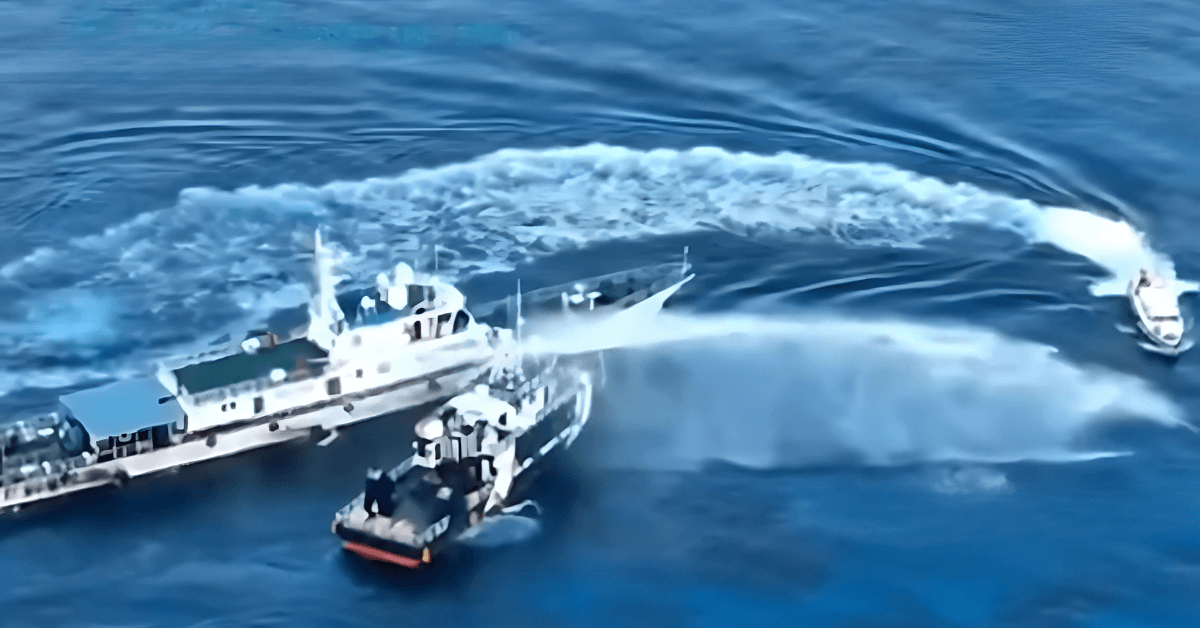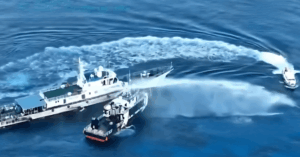
World’s Largest Chinese-Built Car Carrier Sets Sail From Shanghai
May 23, 2025
US Navy Makes History With Largest-ever Airstrike From An Aircraft Carrier
May 23, 2025

Tensions between China and the Philippines have once again escalated after a series of confrontations in the disputed South China Sea.
The Philippine Coast Guard accused China’s coast guard vessel 5205 of intentionally ramming one of its largest cutters, the 97-metre-long Teresa Magbanua. The ship sustained damage, but no crew members were hurt, according to officials.
The Philippines released video footage of the incident during a press briefing and claimed the Chinese action was unprovoked.
On the other hand, China’s coast guard stated that a Philippine vessel “illegally stranded” at the shoal had lifted anchor and deliberately hit a Chinese ship. They called for the immediate withdrawal of the Philippine vessel and warned that they would take necessary measures to counter any provocation. A Chinese official stated that their coast guard would “resolutely safeguard the country’s territorial sovereignty and maritime rights.”
This is the fifth encounter between Chinese and Philippine vessels in the last month alone.
A day earlier, another confrontation took place around a reef in the Spratly Islands. The Philippines’ Bureau of Fisheries and Aquatic Resources reported that the Chinese Coast Guard fired water cannons and sideswiped one of its research vessels, the Datu Sanday, along with a second ship.
The bureau condemned the action as “aggressive interference” and said that this was the first time their vessels had faced water cannon attacks in that part of the sea.
China’s Coast Guard responded by saying that the Philippine vessels had entered waters near Subi Reef and Sandy Cay illegally. They also accused the Philippines of attempting to send personnel to land on Sandy Cay.
Video Credits: Manila Standard/YouTube
Chinese officials claimed they took lawful and professional control measures and blamed the collision on a Philippine vessel that approached one of their ships despite repeated warnings. However, the Chinese statement did not mention the use of water cannons.
U.S. Ambassador to the Philippines MaryKay Carlson called China’s actions aggressive and warned that they had “recklessly endangered lives” and threatened the stability of the region.
Sandy Cay lies near Thitu Island, the largest and most strategically significant of the nine outposts occupied by the Philippines in the Spratly archipelago. This area is also claimed in parts by China, Malaysia, Vietnam, Brunei, and Taiwan. Last month, China said its Coast Guard had landed on Sandy Cay to assert sovereignty, a claim the Philippines strongly denied.
Meanwhile, the Permanent Court of Arbitration ruled in 2016 that China’s sweeping claims in the South China Sea had no legal basis under international law. Beijing has continued to reject the ruling.
Additionally, the Philippine maritime council reported this week that Chinese aircraft made unsafe manoeuvres near a civilian aircraft conducting patrols over the Scarborough Shoal and Subi Reef.
On Sunday, the Philippines accused China of blocking a resupply mission to Filipino fishermen. A vessel from the Philippine fisheries bureau, transporting food, fuel, and medical supplies, was rammed and hit with water cannons by Chinese ships.
In April, Manila deployed a ship to Sabina Shoal, which is about 140 kilometers from Palawan province and around 1,200 kilometers from China’s Hainan Island.
Philippine officials have accused China of trying to build an artificial island in the area. They reported finding piles of dead and crushed coral on the sandbars, which they believe points to early island-building efforts, a claim Beijing has denied.
Despite the repeated clashes, Philippine officials have stated that they will not pull their ships from these disputed areas. They criticised what they described as China’s harassment, bullying tactics, and dangerous actions.
The South China Sea remains a major hotspot in the region, not just for territorial claims but also because of its strategic importance. An estimated $3 trillion worth of global trade passes through it annually. The area is believed to hold large deposits of oil and gas, along with rich fish stocks.
Reference: abc.net, interaksyon.philstar
Source: Maritime Shipping News


